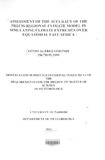| dc.description.abstract | This study aimed at assessing the performance of the PRECIS (Providing Regional Climate for
Impact Studies) regional climate model (RCM) in simulating the extreme climate events in the
equatorial East Africa region.
The data used included daily simulations obtained from the PRECIS model daily runs carried out
at ICPAC (lGAD Climate Prediction and Application Centre). Quality-controlled daily station
observed maximum and minimum temperature together with daily rainfall totals for 13 unevenly
distributed stations over the region were used.
Identification of trends of extremes in observed rainfall and temperature records was achieved
through graphical analysis, regression analysis and Mann Kendall non parametric test.
Evaluation of the skill of the PRECIS regional climate model in simulating the past and present
regional rainfall and temperature extremes was achieved using graphical analysis, correlation
analysis, and Root Mean Square Error (RMSE) analysis; the PRECIS model was used to project
future trends of rainfall and temperature extremes over equatorial East Africa.
Analysis of trend of the past and present patterns of rainfall and temperature extremes over
equatorial East Africa showed that observed trends of maximum temperature extremes have
significantly increased leading to hotter days and warmer nights. There has been a decrease in
cooler days and colder nights. Decreasing trends in observed extremes generated from minimum
temperature data were identified. Precipitation extremes generally showed a decrease in annual
rainfall totals.
Results from correlation analysis, and Root Mean Square Error (RMSE) analysis indicated
relatively low skill of PRECIS in simulating regional climate extremes, especially for
precipitation extremes. The graphical methods, however, showed that the PRECIS model was by
and large able to represent the peaks of temperature and rainfall extremes. There were, however,
significant differences in the magnitudes of the peaks. This may reflect the relatively low values
that were obtained from correlation and large RMSE values. Better simulation results were
obtained for maximum and minimum temperature. The correlation coefficient values varied from
0.02 to 0.69 while root mean square errors were between 4.86 and 25.57 over the equatorial East
Africa.
PRECIS model projections for the future period 2030-2070 indicated increasing trends of
maximum temperature extremes and decreasing trends of minimum temperature extremes.
Simulations of extreme rainfall events were not consistent in several locations with certain
stations recording increasing trends, others decreasing while at other stations there was no
apparent trend.
The PRECIS model was used to project the future climate extremes in equatorial East Africa.
This was after ascertaining that the results of validation period showed fairly good agreement
between observed temperature-based indices extremes. The model results for the precipitationbased
indices showed that the model depicted the direction but had some bias and in certain
instances underestimated the observed trends.
In conclusion, the outcome points to the intensification of dry and warm conditions over the
study area while the frequency of such dry events is also bound to increase. There is also decline
in cool conditions Extreme precipitation events were found to be concentrated over short periods
which were also occurring under already wet conditions. This implies even though dry
conditions will be more frequent in the area; there is also the likelihood of high precipitation over
short durations leading to flush floods.
Flood episodes more often lead to displacement of people, killing of both livestock and human,
outbreaks of water-borne diseases such as cholera. Droughts on the other hand lead to human
wild life and human-human conflicts over scarce water resources, deaths as a result of
malnutrition environmental degradation among others. These results can be used In many
regional climate change applications including impacts, vulnerability, mitigation and adaptation
assessment studies so as to alleviate human suffering. | en |

